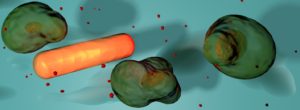Martin Baaske and Nasrin Asgari are working on this project.
Proteins, the engines that drive and regulate almost all processes in living organisms, come in many shapes and sizes. As they are all made from a limited set of building blocks, their identification is difficult. Current identification techniques are either marker-based, in which case a specific label must be tethered to the protein, or have to use substrates with receptor sites that specifically bind the proteins of interest. Both types of sensors require time- and work-intensive chemical protocols, which require precise knowledge of the analyte’s structure. Moreover, these methods do not recognize non-targeted molecules – a severe drawback for the study of metabolic processes without a priori knowledge of all involved molecular species.
This is where our research comes in. We develop optical biosensors that do not rely on markers or on analyte immobilization. Instead, we aim to identify proteins via measurements of their physical properties only. For this purpose we employ plasmonic nanoparticles which, by means of careful and intricate optimization of the optical probing device and the electronic hardware, can be transformed into tiny high-speed, high-throughput nanosensors enabling the observation of untethered “free” proteins.

Artist’s view of sensing of biomolecules of different size by a single gold nanorod.


